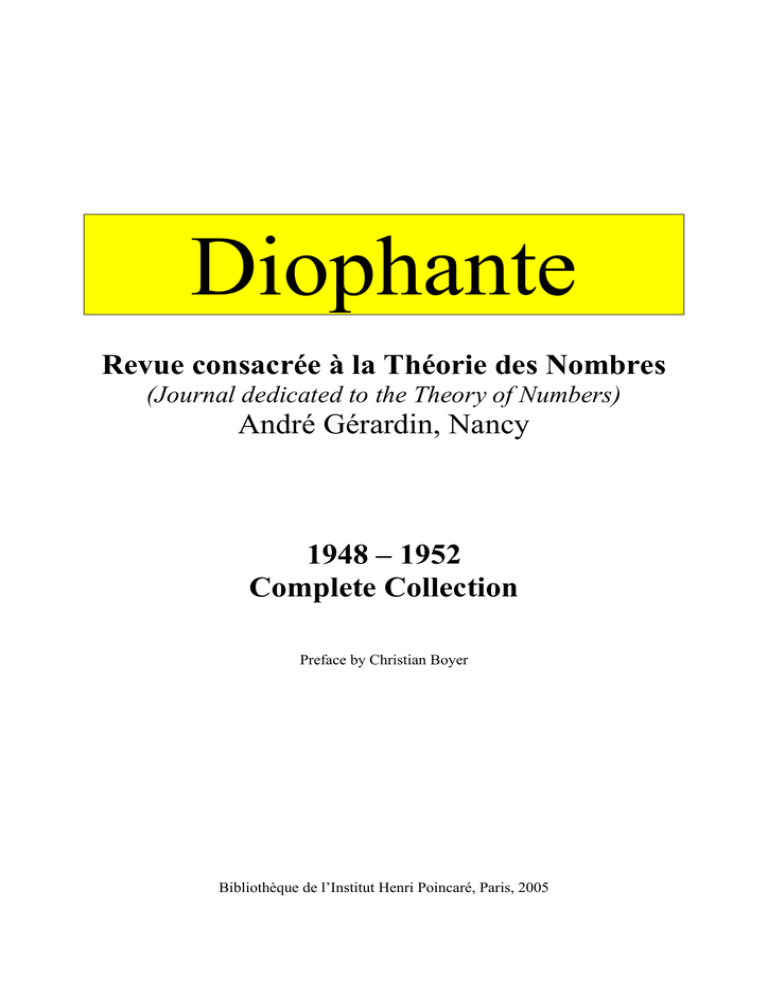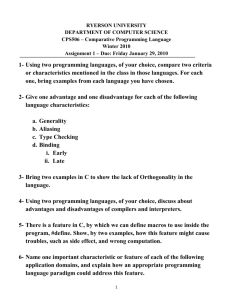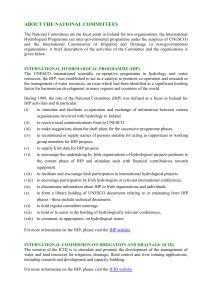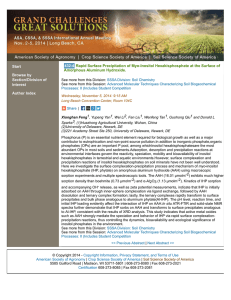Diophante André Gérardin, Nancy Revue consacrée à la Théorie des Nombres
advertisement

Diophante Revue consacrée à la Théorie des Nombres (Journal dedicated to the Theory of Numbers) André Gérardin, Nancy 1948 – 1952 Complete Collection Preface by Christian Boyer Bibliothèque de l’Institut Henri Poincaré, Paris, 2005 Diophante – Préface page I Preface It has been a great joy to discover the original copies of this journal, Diophante, in the basement of the Institut Henri Poincaré. The first years of this “journal dedicated to the theory of numbers” (“Revue consacrée à la théorie des nombres”, as written in each its front pages) were long believed to be lost. Until recently, the only issues known were, to my knowledge, those of the last two years, in the possession of the library of the Ecole Polytechnique[1]. The collection now becomes complete! Diophante was edited in Nancy, France, by André Gérardin from 1948 to 1952. Only a very small number of issues were produced. Gérardin, a member of the Société Mathématique de France beginning in 1906, was one of the most cited mathematicians in Leonard Eugene Dickson’s monumental work, History of the Theory of Numbers[2]. André Gérardin (Nancy 1879 – Nancy 1953) André Gérardin, probably “the most active mathematical descendant of Edouard Lucas” in France[3], strongly participated in four publications: • For many years he edited his review Sphinx-Oedipe[4], beginning in 1906 • In 1943-1944 he published several issues of the Lettre Mathématique Circulante, of which no example is currently known • In 1944, he partnered with Paul Belgodère in launching the journal Intermédiaire des Recherches Mathématiques[5] • In 1948, at the age of 69, he began publishing Diophante, which he published up until his death. In 1949, shortly after the launch of Diophante, his friend Paul Belgodère (who was at that time the secretary of the Société Mathématique de France) became the director of the library at the Institut Henri Poincaré in Paris, a post that he held until 1986. With life annuities, Belgodère purchased the very important mathematical library that Gérardin had put together at Nancy. Many books and journals of the IHP library that readers can freely consult today once belonged to Gérardin personally! Diophante – Préface page II I would like to thank Mrs. Liliane Zweig, since 2003 the director of the IHP library, as well as Mr. Dominique Dartron, assistant librarian, who quickly responded to my request of October 2004 by determining whether there were boxes with Gérardin’s name located in the basement of the IHP. It is in these boxes that I found several large dusty rolls which later proved to contain the originals of the journal Diophante in A2 format (four pages per translucent tracing paper sheet), returned to Gérardin after heliography printing. Containing the original writing of Gérardin in India ink, they were unrolled only with difficulty, as they had stayed rolled up for more than half a century. It is interest to note that the printing firm Marc used to produce the journal in small quantities still exists today, and at the same address. Since no printer can retain examples of all their work, they no longer possess any issues of the journal. The current director of the printing office is the grandson of the director in Gérardin’s time. The original printer, his grandfather, died in 2003, and we only missed the chance to hear anecdotes about Gérardin and the printing of Diophante by a few months. The Marc printing firm of 23, rue des Carmes in Nancy still exists in 2005. The sign "J. Marc" refers to Jacques Marc, who printed the journal Diophante. grandfather of the current director Jean-Pierre Marc. Here are some interesting items taken haphazardly from the pages of Diophante: • the words of Paul Belgodère, who was not yet director of the IHP library, on page 1 of the first issue (Di 1948, p. 1) • Euler’s interesting problem, the "magic square of squares", described by Legendre (Di 1948, p. 11) -- today we know only a little more about this problem, and there are still areas of complete mystery[6] • many unpublished articles of Aimé Ferrier, the author of Les Nombres Premiers[7] which appeared in 1947, just slightly before Diophante. Ferrier was briefly the holder of the record for the largest known prime number, (2148 + 1)/17 (a calculation he describes here), before being surpassed by J. C. P. Miller and D. J. Wheeler. While today we know much larger prime numbers, Ferrier continues to hold a record: his number remains the largest prime number calculated without the aid of a computer[8]. Ferrier performed his long calculations by hand from May to the beginning of July 1951, using only a mechanical office calculating machine. Did this feat help him get named that same year as an Officer of the Legion of Honor (Di 1951, p. 24)? We’d be willing to bet that few in the future will volunteer to beat this record... • the appearance of the first computers, which immediately dethroned manual calculating methods (Di 1949, p. 25-26, Di 1950 p. 12-13, Di 1951 p. 10 and 26) • and other interesting items that you will certainly find yourself! Christian Boyer, Enghien les Bains, April 2005 (English translation by Jeffrey Shallit, December 2005) Diophante – Préface page III Other mathematical works of André Gérardin André Gérardin wrote many articles in different French mathematical journals during the first half of the 20th century, including L’Intermédiaire des Mathématiciens, L’Enseignement Mathématique, and Nouvelles Annales de Mathématiques. More rarely, he wrote for foreign journals, for example, the Belgian journal Mathesis, the Dutch journal Wiskundig Tidschrift, and the British journals Report of the British Association for the Advancement of Science and The Mathematical Gazette. He was also the author of numerous conference presentations at the meetings of the AFAS (Association Française pour l’Avancement des Sciences) and of the Sociétés Savantes du CTHS (Comité des Travaux Historiques et Scientifiques du Ministère de l’Instruction Publique). These contributions were reprinted in the annual proceedings of these two societies, of which he was a member. He participated in five meetings of the International Congress of Mathematicians: Rome in 1908, Cambridge in 1912, Strasbourg in 1920, Bologna in 1928, and Zurich in 1932. He wrote a small booklet entitled Factorisations Quadratiques et Primalité[9]. Long before the computer era, he became very interested in the construction of special-purpose mechanical devices devised to study the primality and factorization of integers. He inspired the machine of Carissan in 1919, rediscovered during the 1990’s, and now on exhibit at the Musée des Arts et Métiers in Paris[10]. An article is in preparation on André Gérardin[11], after the first article published on the discovery of Diophante[12], and it will provide a biography. Congruence machine of André Gérardin, 1937 model. No copy of this machine, or its preceding models, has been discovered. Diophante – Préface page IV References With their availability, in April 2005, in the following French libraries: IHP JMR BCX BMN BNF BSG Bibliothèque de l’Institut Henri Poincaré, Paris Bibliothèque Universitaire de Jussieu Mathématiques-Recherche, Chevaleret, Paris Bibliothèque de l’Ecole Polytechnique, Palaiseau Bibliothèque Municipale de Nancy Bibliothèque Nationale de France, François Mitterrand, Paris Bibliothèque Sainte-Geneviève, Paris [1] Diophante, Nancy, 1948-1952, IHP (the present book, complete collection, BCX (years 1951 and 1952) [2] Leonard E. Dickson, History of the Theory of Numbers, Volume 1 “Divisibility and Primality” and Volume 2 “Diophantine Analysis”, Carnegie Institute of Washington, 1919 and 1920, IHP, JMR, BCX, BNF [3] Anne-Marie Décaillot, L’arithméticien Edouard Lucas (1842-1891): théorie et instrumentation, Revue d’Histoire des Mathématiques, Société Mathématique de France, Tome 4, Fascicule 2, 1998, pages 191-236 (page 225 for the quotation on André Gérardin), IHP, JMR, BCX, BNF, BSG [4] Sphinx-Œdipe, Nancy, 1906-193?, BMN (years 1906 to 1913), BNF (years 1906 to 1928, with gaps) [5] Intermédiaire des Recherches Mathématiques, Hermann, Paris, 1945-1949, IHP, JMR, BNF, BSG [6] Christian Boyer, Some notes on the magic squares of squares problem, The Mathematical Intelligencer, Springer, New-York, Vol 27, N°2, Spring 2005, pages 52-64, IHP, JMR, BCX, BNF [7] Aimé Ferrier, Les Nombres Premiers, Vuibert, Paris, 1949, IHP, JMR, BCX, BNF, BSG [8] Jean-Paul Delahaye, Merveilleux nombres premiers, Belin – Pour La Science, Paris, 2000, pages 166 and 169, IHP, JMR, BMN, BNF, BSG [9] André Gérardin, Factorisations Quadratiques et Primalité, Sphinx-Œdipe, Nancy, 1932, IHP, BSG [10a] Jeffrey Shallit - Hugh C. Williams - François Morain, Discovery of a Lost Factoring Machine, The Mathematical Intelligencer, Springer, New-York, Vol 17, N°3, Summer 1995, pages 41-47, IHP, JMR, BCX, BNF [10b] François Morain - Jeffrey Shallit - Hugh C. Williams, La machine à congruences, La Revue - Musée des Arts et Métiers, Paris, n°14, mars 1996, pages 14-19, BCX, BNF, BSG [10c] François Morain, La machine des frères Carissan, Pour La Science, Paris, n°243, janvier 1998, pages 1011, BCX, BMN, BNF, BSG [10d] Hugh C. Williams, Edouard Lucas and Primality Testing, Wiley-Interscience Publication, Canadian Mathematical Society Series of Monographs and Advanced Texts, Volume 22, 1998, pages 149, 153-156, 160-169, 172, 189, 411, 482-483, BNF [11] Christian Boyer, André Gérardin le disciple oublié d’Edouard Lucas, article in préparation [12] Christian Boyer, Diophante retrouvée, Les Génies de la Science, Paris, N°25, novembre 2005 – février 2006, pages 16-19 Diophante st 1 year - 1948 32 pages Diophante nd 2 year - 1949 32 pages Diophante rd 3 year - 1950 32 pages Diophante th 4 year - 1951 32 pages Diophante th 5 year - 1952 16 pages






